Dr Vino's wine blog
wine talk that goes down easy
Three light, rewarding reds under $20: Produttori, Pataille, Michaud
Finding rewarding light reds under $15 can be as hard as searching for the Holy Grail (but without the killer rabbit). Bump it up to $20 and you can have more options, such as this trio of 2006s. I stretched my dollar by purchasing these in a mixed case.
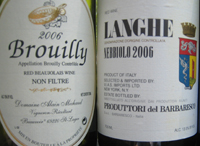 Produttori del Barbaresco, Langhe, Nebbiolo, 2006 about $19
Produttori del Barbaresco, Langhe, Nebbiolo, 2006 about $19
This wine is such a trip! Light in color, the unsuspecting taster might presume it to be “thin” (the ultimate put-down for light bodied reds). Instead, delicious aromas of rose petal and damp earth great the nose. On the palate, great acidity precedes vigorous but interesting and manageable tannins. A great entry-level nebbiolo, a grape that can often escalate in price quickly. I haven’t tried the ’07 of this wine yet, have you?
Lot: 8.143. Imported by VIAS
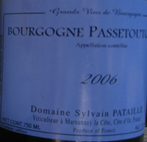 Domaine Sylvain Pataille, Bourgogne-Passetoutgrains, 2006. about $18
Domaine Sylvain Pataille, Bourgogne-Passetoutgrains, 2006. about $18
Blending Pinot Noir? Say it ain’t so. But the practice gets a big “oui” in the appellation of Bourgogne-Passetoutgrains where the wines must be minimum one-third Pinot Noir with the balance the Gamay grape. The result in this 2006 offering from Sylvain Pataille’s 70 year old vines has lipsmacking fruit and acidity and, at 12 percent alcohol, gulpable. On a warm summer evening (when it’s not raining–grr), try serving chilled to 60 degrees for maximum enjoyment.
Lot tasted: LR 01. Becky Wasserman Selection
Alain Michaud, Brouilly, 2006. about $18
I hadn’t tried this Beaujolais producer before but I threw it in my cart. This straight up gamay (as opposed to the Passetougrains) from the strong vintage 2006 has a slight savory note to it as well as wild strawberries. It’s a bigger, broader style within the realm of cru Beaujolais that has a structured but chewy finish. Lot tasted: L. 02 Becky Wasserman Selection
Wine bottle recycling is low – but some bottles getting lighter
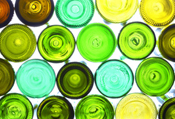 The EPA reports that 28 percent of glass packaging was recycled in America in 2007. If you think that’s low, consider the number for wine (and liquor) bottles: 15 percent.
The EPA reports that 28 percent of glass packaging was recycled in America in 2007. If you think that’s low, consider the number for wine (and liquor) bottles: 15 percent.
It’s a bit of a puzzle why wine (and liquor) bottle recycling rates are so low nationally. While some municipalities require bottle recycling, many more clearly do not. The consumption pattern of wine is amenable to recycling, it would seem, since it’s consumed in a dining room or restaurant: Unlike single-serve water or soda bottles, corks are generally pulled only a few paces from a recycling bin.
Hopefully this rate can rise. The NYT reported that in April, House Democrats introduced a proposal to place a five cent deposit on all beverage containers. (If that ever sees the light of day, hopefully unreturned wine bottles will not see the deposit go to the wholesaler rather than the state’s coffers.) Even though deposits are small where they exist now, the EPA report indicates recycling rates for glass beer and soft drink bottles are more than twice that of wine (and liquor) bottles at 34 percent.
Meanwhile, wine producers are slimming the weight of their bottles. Jancis Robinson once posted a “name and shame” list of heavy bottles. But now the pendulum is starting to swing the other way, if somewhat slowly compared to other drinks. Overseas, Torres is slimming their bottles. Fetzer Vineyards, one of the largest American winemakers, has announced 16 percent lighter bottles. Why? Not only are lighter bottles cheaper for the producer to buy, but the lower mass means lower carbon dioxide emissions during transportation.
On a related note, longtime readers might be interested to note that the paper that I co-authored on the carbon footprint of wine has been published in the current issue of the Journal of Wine Research.
Broadbent sues, California’s anxiety, NY retail, wine cheaper than water
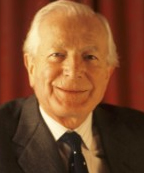 GULP!
GULP!
Michael Broadbent, founder of the wine department at Christie’s, has sued Random House publisher of The Billionaire’s Vinegar (buy on amazon). The Daily Mail writes: “The Broadbent claims the book suggests he invented a bid for another of the Jefferson wines – a half-bottle of 1784 Margaux – to ensure the successful bidder paid more than was necessary.” Random House will defend the lawsuit. The Billionaire’s Vinegar is also being made into a movie. (Image: The Daily Mail)
SPIT: sales
The NYT summarizes the effect of the recession on the California wine industry: “Brutal.” It continues: “Cash may be trickling, but anxiety is gushing forth.”
SWISHED: retail change in NY
A proposal to reform New York’s retail and allow wine sales in supermarket failed earlier this year. One state Senator has introduced new legislation that would allow not only wine sales in supermarkets but also food sales in wine stores and a “medallion” system instead of licensing. Owners could operate more than one location in New York, also a change. Time will tell whether this initiative fares differently. [LoHud]
SIPPED: ultra low prices
An (unlabeled) Australian wine is selling for $1.99 at a store in Sydney, or “cheaper than water.” Meanwhile, John Brecher and Dorothy Gaiter estimate that the value of juice in Fred Franzia’s new Down Under Chardonnay (retail: about $3) costs “about 35 U.S. cents or less.”
SIPPED: Schmoozing and blogging
Wine Business Monthly reports from the Wine Bloggers’ Conference; Jim Gordon of Wines & Vines has tips for bloggers.
SPIT: stems on Air France
Air France has introduced a new line of stemless wine glasses in Business and First (aka Affaires and La Première). Are the wines served any good? Hit the comments with your on-board experiences.
Lots on labels – but not on American wines
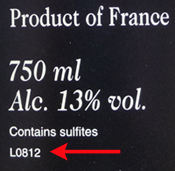 Should wine lot numbers appear on the labels of American wines as they do in Europe?
Should wine lot numbers appear on the labels of American wines as they do in Europe?
The recent saga of Sierra Carche exposed some cracks in the process of wine making, wine reviewing, and wine buying. For those who haven’t checked out the saga (see Felix Salmon’s excellent summary over on Reuters.com), an influential critic gave a wine brand called Sierra Carche the score of 96, retailers sold the wine touting that score, but many consumers then found the wine undrinkable (as the critic also did 10 months later).
Although the mystery of how this could happen remains unresolved, the winemaker has pointed out there were three “lots” (a batch bottled under nearly identical conditions) of the wine and admitted one of those lots a different wine entirely that was bottled as Sierra Carche.
Charlie Olken, publisher of the Connoisseur’s Guide to California Wine, posted several comments on this subject on the previous thread about his experience with lot variation in domestic wines. An excerpt:
I cannot name the winery because of legal reasons, but I was asked to testify in a law suit in which a winery sued another company over wine lost in an accident. It turned out the winery had sold out of the wine in about eight months and simply went out on the open market and purchased wine in bulk and bottled it as their own under the same label. In discovery, it was found that the lost wine had 20% Chenin Blanc purchased at wholesale at a price way below what labeled grape would have cost.
Unless wineries are required to identify separate lots, whether they are bottling wine in California or Spain or Morocco, these kinds of events will continue to happen. Sometimes it will be only a slight difference in character as in the Ste. Michelle and Mondavi examples above, but the potential for mischief when anybody can bottle several lots under the same label is real and the Sierra Carche is not the only bad example.
Lot labeling has been mandatory in the EU since the early 1990s to facilitate traceability in the event of a recall or consumer complaint. Importer James Koch also posted to the comments: “I have been selecting wines by lot numbers since 1992 – a year after lot numbers started to appear on every bottle of wine – when I discovered that ‘bottle variation’ often is just the result by mixing up different lots. Due to the lot numbers I’ve been able to offer my clients the wines I tasted and selected on my wine buying trips – not only VERSIONS of it.” Koch also pointed out that lot numbers may be difficult to see since it can appear anywhere on the outside packaging material. Lot numbers must start with the letter “L” in Europe.
But American wineries are not required to print lot numbers on bottles. They should. And they should have a standard of 100 percent accuracy. Maybe some progressive wineries will start to do this as Bonny Doon has with ingredient labeling.
Several factors can cause bottle variation to the consumer and disclosing lots would at least provide more transparency. Remember all those consumers who found variation in Two Buck Chuck? Lot numbers could help sort out some of that.
Do you think critics should also list lot numbers in their reviews?
Nude nymph label banned in ‘Bama
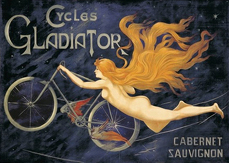 Alabama’s liquor authority has banned a label depicting a nude nymph (side view!) from a 1895 poster. The wine, Cycles Gladiator, made by Soledad, California-based Hahn, retails for about $10 and had sold about 600,000 cases since 2006. Although it is available in the other 49 states, Alabama regulations prohibit labels with “a person posed in an immoral or sensuous manner,” according to NBC Los Angeles. (Search for Cycles Gladiator at retail)
Alabama’s liquor authority has banned a label depicting a nude nymph (side view!) from a 1895 poster. The wine, Cycles Gladiator, made by Soledad, California-based Hahn, retails for about $10 and had sold about 600,000 cases since 2006. Although it is available in the other 49 states, Alabama regulations prohibit labels with “a person posed in an immoral or sensuous manner,” according to NBC Los Angeles. (Search for Cycles Gladiator at retail)
Since when is nude bicycle flying considered immoral or sensuous? Imprudent and unsafe would be more like it. If the nymph were in today’s Tour de France, she would at least be required to have a helmet!
In other important wine and cycling news, after the grueling day up Le Mont Ventoux, Lance Armstrong tweeted: ““went to dinner with the RadioShack guys [his new team]…had a few more glasses of wine than I normally would.†And after the tour he posted a pic enjoying a (large) glass of wine with cycling legend Eddie Merckx. The man clearly enjoys wine, so how long until we see an Armstrong celebrity wine? If it ever arrives, he will, no doubt, be fully clothed.
The Sierra Gap – and more on American wine consumers
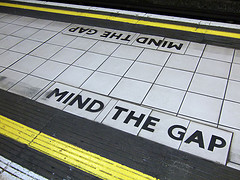 People in California have a higher opinion of the quality and the value of wine produced in their state than do residents of the other 49 states. This phenomenon, dubbed “the Sierra gap,” (no, after the Sierra Nevada mountains, not Sierra Carche!) comes from the 2008 Wine Market Council survey. Fully 63 percent of Californians think that California wine offers better quality than similar wines as compared to 54 percent of respondents not from California. And in the question of value, the split was even wider at 73 percent versus 58 percent.
People in California have a higher opinion of the quality and the value of wine produced in their state than do residents of the other 49 states. This phenomenon, dubbed “the Sierra gap,” (no, after the Sierra Nevada mountains, not Sierra Carche!) comes from the 2008 Wine Market Council survey. Fully 63 percent of Californians think that California wine offers better quality than similar wines as compared to 54 percent of respondents not from California. And in the question of value, the split was even wider at 73 percent versus 58 percent.
This fascinating finding may bear upon our discussion of around the comments from wine importer Bobby Kacher about why so few tasty American wines under $12?
I asked John Gillespie, president of the the Wine Market Council how his survey data differ from the annual Gallup poll, which we discussed recently. As a reminder, our description on the Gallup wine drinkers: “If an alien landed in a room full American wine drinkers, it would meet mostly college educated, AARP eligible women, probably not from the midwest.”
Gillespie writes to describe how his results compare to Gallup:
You will see that among core wine drinkers (those who drink wine once a week or more often) there is a slight tilt in the direction of males. You’ll also see the a higher percentage of males are reporting an increase in their wine consumption. And when you look at the gender ratio by generation, you will see that younger groups are either gender neutral, or, in fact, skew male. So while the college educated AARP eligible female wine drinker does exist, we should keep in mind that just down the bar there are a couple of guys in their 20s drinking Malbec and texting their friends to come join them.
Among wine drinkers (also from the 2008 Wine Market Council survey of U.S. wine drinkers) is is true that a higher percentage of females (69%) say they prefer wine to other forms of beverage alcohol (56% of males say this). But
the reality is that among core wine drinkers (who account for about 90% of all wine consumed) there are more males than females, and that younger wine drinkers skew male, not female.
The Wine Market Council data also show that the youngest drinkers, a large generation younger than about 32 known as millennials, already consume the second most wine as a group and have the fastest growth rate at 46 percent. That’s quite a contrast to Europe, where younger drinkers are drinking less wine.
Slides after the jump. Read more…
Anthony Dias Blue, bloggers, and the exposure package
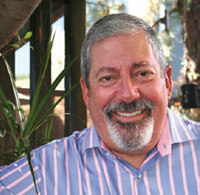 Anthony Dias Blue published an editorial in the July issue of his print publication, The Tasting Panel entitled, “…And Who Regulates the Bloggers?†In it, he calls me–without naming me specifically–a “barbarian blogger.” He further suggests that I “cast aspersions” at Robert Parker and his staff in my two posts from April and uses the word “allegedly” to describe the trips taken by contributors at The Wine Advocate. Then he pivots to lash out at bloggers more generally. You can read the whole piece here, but here is one excerpt:
Anthony Dias Blue published an editorial in the July issue of his print publication, The Tasting Panel entitled, “…And Who Regulates the Bloggers?†In it, he calls me–without naming me specifically–a “barbarian blogger.” He further suggests that I “cast aspersions” at Robert Parker and his staff in my two posts from April and uses the word “allegedly” to describe the trips taken by contributors at The Wine Advocate. Then he pivots to lash out at bloggers more generally. You can read the whole piece here, but here is one excerpt:
And who are these bloggers anyway and, more important, what is their motivation? It would be comforting to find that they are altruistic wine lovers who see their purpose as bringing insight and valuable information to like-minded consumers. But the image that presents itself is of bitter, carping gadflies who, as they stare into their computer screens and contemplate their dreary day jobs, let their resentment and sense of personal failure take shape as vicious attacks on the established critical media.
I’m sure this is a condition that could be quickly remedied by the appearance at their door of the FedEx man bearing multiple new release samples.
Here’s a copy of the letter I sent to Mr. Dias Blue via email.
Mr. Dias Blue,
I saw your editorial in the July issue of your magazine, The Tasting Panel.
As the “blogger barbarian” who asked the questions of Robert Parker and Jay Miller, I thought I should clarify a few things for you.
Your use of “allegedly” significantly underplays the reality of press trips at The Wine Advocate. Squires by his own admission took a press trip to Israel and later divulged that he has taken five such trips to Portugal and Greece. Miller refused to provide a substantive reply to my specific questions about his travel to Argentina. A few phone calls and emails later, I triple verified that he had been to Argentina on two trips, paid for and organized by Wines of Argentina. The head of Wine Australia USA later told the Wall Street Journal that they had paid for and organized Miller’s trip to Australia. He put the price tag on that trip at $25,000.
Robert Parker built his reputation on independence. A key part of that independence involved distance from the trade and accepting no freebies. There had been a divergence between the actions of contributors to the publication and the stated policy.
And just to underscore the importance of this issue, I was not the only one asking questions since the Wall Street Journal also ran a story on the issue.
On my blog I have a statement of ethics. Do you have one in The Tasting Panel magazine?
I notice that part of Blue Lifestyle includes the organization of many promotional events for the wine trade and press. Further, I have personally received invitations from Blue Lifestyle for events with wine producers of Brunello, Walla Walla, Vintage port 2007, Wines of Navarra and E&J Gallo. How do you reconcile your promotional work with your editorial work?
Also, how do you reconcile the ads for 13 spirits brands in the current issue and the ads for eight wine brands with the independence of the editorial? Indeed, two of those advertisers also received editorial coverage in the same issue.
Mr. Dias Blue, I did not “cast aspersions” about Robert Parker and Jay Miller as you suggest. I asked them questions and when their replies were not forthcoming, I found out the answers and then gave them a chance to respond. That is called journalism. And as I stated in the pieces, I have tremendous respect for what Mr. Parker has achieved.
The invective that you present in your editorial, by contrast, pays scant regard for the facts and uses charged rhetoric to cast many aspersions writ large about wine bloggers. How do you expect to earn the respect of your readers by presenting such an unbalanced, overheated view? Instead, it sounds precisely like the form of writing that you decry.
Sincerely,
Tyler Colman, Ph.D.
www.DrVino.com
* * * *
After the jump, details about his pay-for-editorial “exposure package,” a further point about bloggers, and a reply from Anthony Dias Blue. Read more…
Sierra missed – the saga of Sierra Carche 2005
What happens when a reviewer tastes a good bottle, but some consumers buy what appears to be a completely different product? Think it couldn’t happen? Guess again and behold the saga of Sierra Carche 2005.
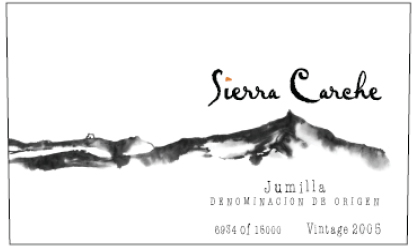
Last fall, Wine Library, the Springfield, New Jersey wine retailer, sent out an email offering for a wine that seemed to be the wine lover’s dream: a fantastic quality-to-price ratio. The wine on offer was the Sierra Carche 2005, a blend of Monastrell with Petit Verdot and Malbec from the off-the beaten path Spanish region of Jumilla. Jay Miller, a critic at the Wine Advocate, described it as “Inky purple, the wine offers an array of scents which jump from the glass… structured wine with gobs of flavor, terrific intensity… It will provide pleasure through 2025.” He awarded it 96 points. The suggested retail price was $40; Wine Library was offering it for $29.99. Robert Kenney, a New Jersey wine consumer, was so enthusiastic upon seeing the email that he ordered several six packs.
But Kenney’s euphoria turned sour as soon as he pulled a cork. He later wrote on the forums at erobertparker.com that “I have consumed 6 bottles already, praying that with each popped cork, a different genie will emerge…so far, no such luck…slapping 80 points on those bottles is generous.”
Kenney describes himself as an “unabashed fan of DrBigJ,” as Miller is known. But Kenney was so disappointed with the wine that he corresponded with Miller and FedExed Miller one of his bottles last fall for him to taste and “see if indeed it was indicative of the wine that he had tasted and scored highly.” Kenney wrote last week that “During a ten month period I had exchanged seven emails with DrBigJ, reminding/imploring him to taste the sent bottle…to no avail.”
Then a consumer in Pittsburgh, Bob Hudak, posted that he had found the wine for $38 at the PLCB, the state-run store in Pennsylvania. On July 5, Hudak wrote of his experience, “Considering that it was a Dr Big Jay 96 pointer in the WA, I figured I buy 6 bottles. I opened my first one this weekend. Big mistake. The wine had virtually no aroma at all. You couldn’t smell a darn thing. With time and air, some stinky aromas that were off-putting became noticeable.”
Kenney chimed in on the thread as did several other consumers with their negative experiences with the wine. (The wine’s scores on cellartracker.com were not all bad although several reviewers took the time to note flawed bottles and one gave it a 74 but the modal score was around 90.)
On July 14, Miller posted to the forum that he finally opened the bottle Kenney had sent him and declared it “undrinkable.” Miller contacted the importer of the wine, Mark Clinard of Well Oiled Wine Co., who replied, “We have had similar problems with this wine and had a meeting in March with the winery to find out what the problem is. There was clearly some substandard product shipped by the winery and we have had to take back a large chunk of this wine from the market because it was rejected by the trade. I apologize on behalf of the winery for this apparent bait and switch. Going forward we are searching for a different winery for this brand.” He posted his cell phone number and asked that those consumers with problems contact him.
Brandon Warnke, Vice President of Operations at Wine Library, posted that anyone who bought the wine through the store could return it to them for a full refund.
Jay Miller then wrote: “this is about the worst thing that can happen to a critic, to be tasted on a fraudulent wine, publish a note, and then have readers spend their good money on a fairly pricey wine only to find out that it’s plonk or worse. Its reminiscent of the furor over Las Rocas a few years ago that nearly killed that brand. It’s a bad situation all around.” Read more…



